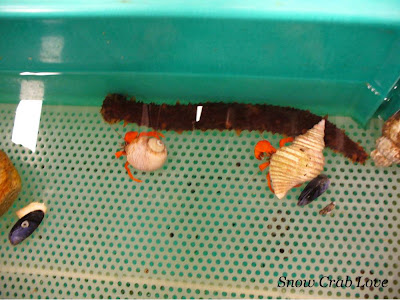My friends Torrie Behrens and Ben Penzick recently got back from an amazing trip to the Galapagos, and they couldn't wait to share their crab photos with us! (Really, they took a lot of amazing photos of a lot of awesome animals, but we'll just stick to the crabs here.)
Me: When were you in the Galapagos? Where did you actually get to walk around?
including Sally Lightfoot crabs (Grapsus grapsus)!!!
What did you learn about the crabs you saw?
We learned that the Sally Lightfoot crabs are not endemic to the Galapagos, but can be found throughout the Americas.
crabs, on the rocks
Their coloration is used to attract mates and they're not born with those colors. Their colors vary a lot; I found the most with blue on their chests, and some had very brilliant blues while others were much more pale.
check out this crab's colors! so bright!
When the crabs are born they're a dark rock color which allows the young to blend in with their habitat.
a juvie Grapsus grapsus
They have a lot of predators in the Galapagos including the Lava Heron.
"Lookin' for crabs in all the wrong places." - lava heron
The crabs are not as fearless as most species in the Galapagos, our guide suggested it was because Herons cast a similar shadow of humans, of a different scale, and it makes the crabs scurry away.
They molt their carapaces when they need to grow (their shells do not grow with them) including their eyeballs! Once they molt, they back out of their previous shell and go into hiding because they need to allow time for their shell to harden. At this point, they're soft shell crabs. We also learned that Europeans do not eat soft shell crab!
Ben with a "t-shirt" or molt
Torrie rockin' some crab fashion
Claws regenerate! (through the molting process: when they shed that hard shell, they can begin to regrow their missing limbs while soft, though it takes a few molts to regenerate fully)
They are able to move so well over rocks because they have two joints that function in different directions allowing full movement of each of their limbs.
mechanics of a molt's legs
The crabs share a habitat with the marine iguanas, and are often climbing right over them, which doesn't bother the iguanas at all.
sharing (space) is caring: it can be fun!
for whatever reason, this iguana cracks me up:
it looks so tiny next to that crab!
it looks so tiny next to that crab!
[More crabs with animals!]
sea lion and surf
they even hang out with penguins! (see the red dots?)
What else did you see?
While traveling, we also saw Ghost Crabs that have eyes almost floating above their bodies. They lived in holes in the ground on the beach and would only come out if we were very still and didn't make any vibrations. And we saw freshwater crabs in the Amazon swamp, mangrove crabs along the coast, and various super tiny crabs along mainland Ecuador's coast and hermit crabs!
a freshwater crab spotted in Ecuador!
Thanks, Ben and Torrie, for letting me share your photos and fun facts!


















































